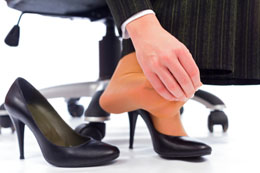Plantar flexion is an ankle movement that causes the movement of the foot away or towards the body. This action flexes the muscles of the toe and foot toward the sole.

The ankle of a human body is a hinged joint, capable of moving the foot away from the body or towards the body. This movement is made possible by the meeting of three bones:
tibia (shinbone of leg),
fibula (the small bone in leg), and the
talus (a large bone in foot). The end of tibia constitutes the inner portion of the ankle, whereas the outer portion of the ankle is formed by fibula. The bony bulges on either side of the ankle are called
malleoli which aid in stability of the ankle joints while standing or walking. Plantar flexion can be defined as a toe down movement of the ankle, helping to move the foot away from the body.
Ankle Plantar Flexion
This can be described as a movement that increases approximately 90 degree between tibia and front part of the body. In short, it is a movement away from the body and towards the body. The plantar flexion range of motion is between 30 degree and 50 degree. The primary muscles involved in plantar flexion are:
- Peroneus longus (this is one of the core plantar flexors that everts foot)
- Gastrocnemius (this is an important plantar flexor that aids in flexing knees)
- Soleus (this plantar flexes and fixates the ankle)
- Plantaris (this plantar flexes the ankle and the knee)
- Tibialis posterior (this is another core plantar flexor for ankle that inverts foot)
Most athletes at one time or the other, experience plantar flexion pain that is mostly around the ankle and heel. The cause of this pain is plantar fasciitis, which is a chronic injury caused due to repetitive plantar flexion. At times, morning foot pain is felt when taking the first few steps out of bed. This happens when the foot has been constantly resting in plantar flexion motion all through the night. This pain can also be caused due to excessive weight gain or a sudden change in exercise routine.
Constant plantar flexion can lead to foot problems like heel pain, flat feet, abrupt changes in daily activities, and tight achilles tendonitis. However, these problems are easily curable by following some exercises as listed below.
Exercise Regimen
To prevent aching feet, one needs to strengthen the lower leg muscles and shin splints. Athletic activities stress the ankles to a great extent. Even walking and standing for long durations of time can cause pain in the ankles. So, to strengthen ankles and leg muscles, plantar flexion exercises are a must. Here are some of the best suggested exercises to get rid of this condition.
Exercise 1
- Lie down on a mat. Keep your knees straight.
- Push your feet away from the body and continue until a discomfort is felt in the ankle.
- Maintain the posture for around 15 seconds and then return to the neutral position.
- Repeat this exercise on a daily basis and feel the difference.
Exercise 2
- Go near a table or a chair and stand straight. Your feet must be aligned with the floor.
- Gradually, raise your toes and stand on them for about two seconds.
- Now, gradually bring your heels back to the floor and wait for a second.
- Repeat this exercise 10-20 times daily and feel the stamina returning to your calf muscles and shin bone.
Exercise 3
- In case of an injured muscle, outstretch the injured leg.
- Take a tube and loop it around the ball of the foot.
- Hold both ends of the tube in hand and pull with force.
- Press the ball of the foot gently and stretch the tube. Pause for a second and return to normal position.
- Repeat the procedure 10 times on a regular basis.
Apart from the aforementioned exercises, it is better to avoid activities like walking and running barefoot on irregular surfaces and stairs. Massaging fascia, weight-loss treatments, taping arch and heel, skipping, walking, and jogging with foot lifts are some effective treatments for curing this pain. Follow a proper exercise regimen for a healthy ankle movement.
Disclaimer:
This Buzzle article is for informative purposes only, and should not be used as a replacement for expert medical advice.


 The ankle of a human body is a hinged joint, capable of moving the foot away from the body or towards the body. This movement is made possible by the meeting of three bones: tibia (shinbone of leg), fibula (the small bone in leg), and the talus (a large bone in foot). The end of tibia constitutes the inner portion of the ankle, whereas the outer portion of the ankle is formed by fibula. The bony bulges on either side of the ankle are called malleoli which aid in stability of the ankle joints while standing or walking. Plantar flexion can be defined as a toe down movement of the ankle, helping to move the foot away from the body.
The ankle of a human body is a hinged joint, capable of moving the foot away from the body or towards the body. This movement is made possible by the meeting of three bones: tibia (shinbone of leg), fibula (the small bone in leg), and the talus (a large bone in foot). The end of tibia constitutes the inner portion of the ankle, whereas the outer portion of the ankle is formed by fibula. The bony bulges on either side of the ankle are called malleoli which aid in stability of the ankle joints while standing or walking. Plantar flexion can be defined as a toe down movement of the ankle, helping to move the foot away from the body.